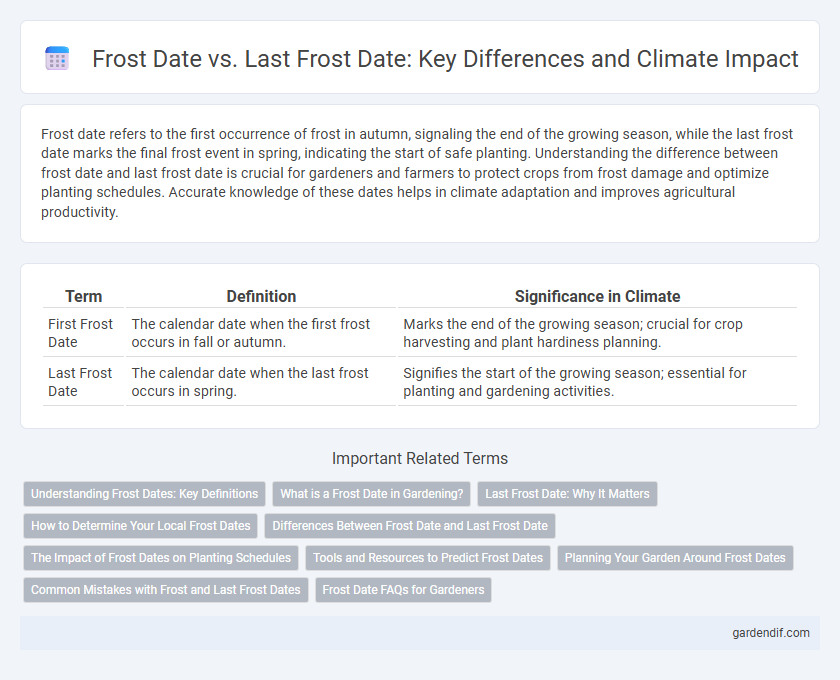
Frost date vs Last frost date Illustration
Frost date refers to the first occurrence of frost in autumn, signaling the end of the growing season, while the last frost date marks the final frost event in spring, indicating the start of safe planting. Understanding the difference between frost date and last frost date is crucial for gardeners and farmers to protect crops from frost damage and optimize planting schedules. Accurate knowledge of these dates helps in climate adaptation and improves agricultural productivity.
Table of Comparison
| Term | Definition | Significance in Climate |
|---|---|---|
| First Frost Date | The calendar date when the first frost occurs in fall or autumn. | Marks the end of the growing season; crucial for crop harvesting and plant hardiness planning. |
| Last Frost Date | The calendar date when the last frost occurs in spring. | Signifies the start of the growing season; essential for planting and gardening activities. |
Understanding Frost Dates: Key Definitions
Frost date refers to the specific day when frost first occurs in a given area, marking critical thresholds for planting and crop protection. Last frost date indicates the final occurrence of frost in spring, guiding gardeners and farmers on safe planting times to avoid damage. Accurate knowledge of both frost date and last frost date is essential for effective agricultural planning and minimizing frost-related crop losses.
What is a Frost Date in Gardening?
A frost date in gardening refers to the average calendar date when the first frost of the season is expected to occur, which is critical for protecting sensitive plants from cold damage. The last frost date marks the final spring frost, signaling the safest time to plant frost-sensitive crops outdoors. Understanding frost dates helps gardeners plan planting schedules, reducing the risk of frost injury and optimizing crop yields.
Last Frost Date: Why It Matters
The last frost date marks the final expected occurrence of freezing temperatures in a region, critically impacting planting schedules and crop selection. Gardeners and farmers rely on this date to prevent frost damage to tender plants and maximize growing season length. Accurate knowledge of the last frost date helps optimize agricultural productivity and reduces the risk of crop loss due to unexpected cold snaps.
How to Determine Your Local Frost Dates
Determining your local frost dates involves monitoring historical temperature data and tracking the average dates of the first and last frost in your area, which vary based on climate zones and elevation. Utilize resources such as the National Weather Service or regional agricultural extensions that provide frost date maps and averages tailored to specific zip codes or geographic coordinates. Recording nighttime temperatures consistently during early spring and late fall helps refine these estimates, ensuring accurate planting and harvesting schedules for frost-sensitive crops.
Differences Between Frost Date and Last Frost Date
Frost date refers to the specific calendar day when the temperature first drops to 32degF (0degC) in a given area, signaling the onset of frost conditions. Last frost date marks the final occurrence of frost in spring, indicating the safe time for planting frost-sensitive crops and outdoor gardening. Understanding the differences between frost date and last frost date is crucial for effective agricultural planning and minimizing crop damage due to cold temperatures.
The Impact of Frost Dates on Planting Schedules
Frost date and last frost date are critical parameters in determining optimal planting schedules, as frost date marks the onset of freezing temperatures while last frost date indicates when temperatures consistently stay above freezing. Understanding these dates allows gardeners and farmers to avoid planting too early, which risks crop damage, or too late, which shortens the growing season. Precise knowledge of frost patterns helps maximize plant growth, yield, and overall agricultural productivity by aligning planting times with local climate conditions.
Tools and Resources to Predict Frost Dates
Accurate prediction of frost dates relies on advanced tools such as weather forecasting models, climatology databases, and growing degree day calculators. Online platforms like the National Weather Service and agricultural extension services provide interactive frost date maps and historical climate data to assist farmers and gardeners in planning crop cycles. Satellite imagery and temperature loggers enhance local frost prediction accuracy by monitoring microclimate variations in real time.
Planning Your Garden Around Frost Dates
Understanding the difference between the frost date and the last frost date is crucial for effective garden planning, as the frost date marks the first expected occurrence of frost in autumn, while the last frost date indicates the final frost event of spring. Accurate knowledge of these dates, sourced from regional climate data and historical weather patterns, allows gardeners to schedule planting and harvesting to protect sensitive plants from frost damage. Utilizing frost date calendars specific to your USDA Hardiness Zone increases the success rate of seed germination and the overall health of the garden throughout the growing season.
Common Mistakes with Frost and Last Frost Dates
Confusing the frost date with the last frost date leads to planting errors and crop damage due to misunderstanding temperature risks. The frost date refers to the average first occurrence of frost in autumn, while the last frost date indicates the average final spring frost, critical for timing seed sowing. Ignoring temperature variability and local microclimates often causes misjudgment in frost protection strategies and garden planning.
Frost Date FAQs for Gardeners
Frost date refers to the average calendar day when frost is likely to occur, while the last frost date marks the final expected frost in spring, crucial for planting schedules. Gardeners use the last frost date to determine when it is safe to transplant tender plants or sow seeds outdoors without risk of frost damage. Understanding frost date variability helps optimize crop yield and protect sensitive vegetation from unexpected freezes.
Frost date vs Last frost date Infographic

 gardendif.com
gardendif.com